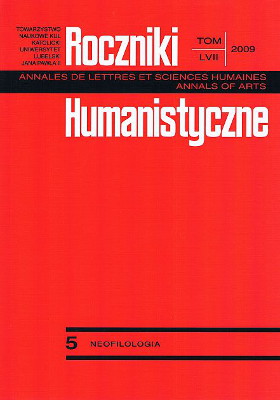Old English Breaking as Sharing of Melody
Abstrakt
[Abstrakt tylko w j. polskim / Abstract only in Polish]
Staroangielska zmiana językowa ‘breaking’ jako dzielenie elementów melodii
Artykuł przedstawia analizę staroangielskiej zmiany językowej ‘Breaking’ z punktu widzenia teorii fonologii rządu w ujęciu Scheera (2004). Najistotniejszym elementem przedstawionej analizy jest założenie, że staroangielski ‘Breaking’ to zmiana, która zachodziła w wyniku uniwersalnego osłabiania spółgłosek znajdujących się w wygłosie sylaby (czyli, w przyjętym modelu, bezpośrednio przed nielicencjonowaną i nierządzoną pustą pozycją samogłoskową). W rezultacie tego osłabiania następuje dzielenie elementów melodii pomiędzy spółgłoską i samogłoską, co w rezultacie wpływa na modyfikację samogłoski.
Bibliografia
Brunner, K. (1965). Altenglische Grammatik. Nach der anglesächsischen Grammatik von Eduard Sievers. 3rd ed. Tübingen: Max Niemeyer.
Bűlbring, K. (1902). Altenglisches Elementarbuch, I: Lautlehre. Heidelberg: Carl Winter.
Campbell, A. (1959). Old English grammar. Oxford: Clarendon Press.
Cyran, E. (2003). Complexity scales and licensing strength in phonology. Lublin: Wydawnictwo KUL.
Daunt, M. (1939). ‘Old English sound changes reconsidered in relation to scribal tradition and practice.’ Transactions of the Philological Society. 108-37.
Davenport, M. (2005) ‘Old English breaking and syllable structure.’ In: Carr, P. J. Durrand and C.J. Ewen (eds.) Headhood, elements, specification and contrastivity. John Benjamins: Amsterdam/Philadelphia.
Fulk, R. (1992). A history of Old English meter. Philadelphia: University of Pennsylvania Press.
Gussmann, E. (2002). Phonology. Analysis and theory. Cambridge: Cambridge University Press.
Hocket, C.F. (1959). ‘The stressed syllabics of Old English.’ Language 35. 575-97.
Hogg, R. (1992). A grammar of Old English. I: phonology. Oxford: Blackwell.
Howell, R. (1991). Old English breaking and its Germanic analogues. Tübingen: Max Niemeyer Verlag.
Jones, Ch. (1989). A history of English phonology. London: Longmann
Kuhn, S. and R. Quirk (1953). ‘Some recent interpretations of Old English digraph spellings.’ Language 29. 372-89.
Kuhn, S. and R. Quirk (1955). ‘The Old English digraphs: a reply.’ Language 31. 390-401.
Lass, R. (1994). Old English. A historical linguistic companion. Cambridge: Cambridge University Press.
Lass, R. and J. Anderson (1975). Old English phonology. Cambridge: Cambridge University Press.
Lowenstamm, J. (1996). ‘CV as the only syllable type.’ In: J. Durand and B. Laks (eds.) Current trends in phonology: models and methods. Manchester: Europeans Studies Research Institute.
Luick, K. (1914-40). (repr. 1964). Historische Grammatik der englischen Sprache. Stuttgart/Oxford: Bernhard Tauchnitz/Basil Blackwell.
Lutz, A. (1991). Phonotaktisch gesteuerte Konsonantenveränderungen in der Geschichte des Englischen. Tübingen: Max Niemeyer Verlag.
Rowicka, G. (1999). Ghost vowels. A strict CV approach. LOT/HIL dissertation 16. The Hague: Holland Academic Graphics.
Samuels, M. (1952). ‘The study of Old English phonology.’ Transactions of the Philological Society 51. 15-47.
Scheer, T. (1998). ‘Governing domains are head-final.’ In: Cyran, E. (ed.) Structure and interpretation. Studies in phonology. Lublin: Folium. 261-285.
Scheer, T. (2004). A lateral theory of phonology. What is CVCV, and why should it be? Berlin and New York: Mouton de Gruyter.
Smith, J. (2007) Sound change and the history of English. Oxford: Oxford University Press.
Stockwell, R. (1996). ‘Old English short diphthongs and the theory of glide emergence.’ In: Britton, D. (ed.) English historical linguistics 1994. Amsterdam/Philadelphia: John Benjamins. 57-72.
Stockwell, R. and C. Barritt (1951). ‘Some Old English graphemic-phonemic correspondences: æ, eA, A.’ Studies in Linguistics, Occasional Papers 4.
Stockwell, R. and C. Barritt (1955). ‘The Old English short digraphs: some considerations.’ Language 31. 372-89.
Suzuki, S. (1994). Breaking, ambisyllabicity, and the sonority hierarchy in Old English. Diachronica 11:1. 65-93.
White, D. (2004). Why we should not believe in short diphthongs. In: Curzan, A. and K. Emmons (eds.) Studies in the history of the English Language II: unfolding conversations. Berlin: Mouton de Gruyter. 57-84.
Copyright (c) 2009 Roczniki Humanistyczne

Utwór dostępny jest na licencji Creative Commons Uznanie autorstwa – Użycie niekomercyjne – Bez utworów zależnych 4.0 Międzynarodowe.





